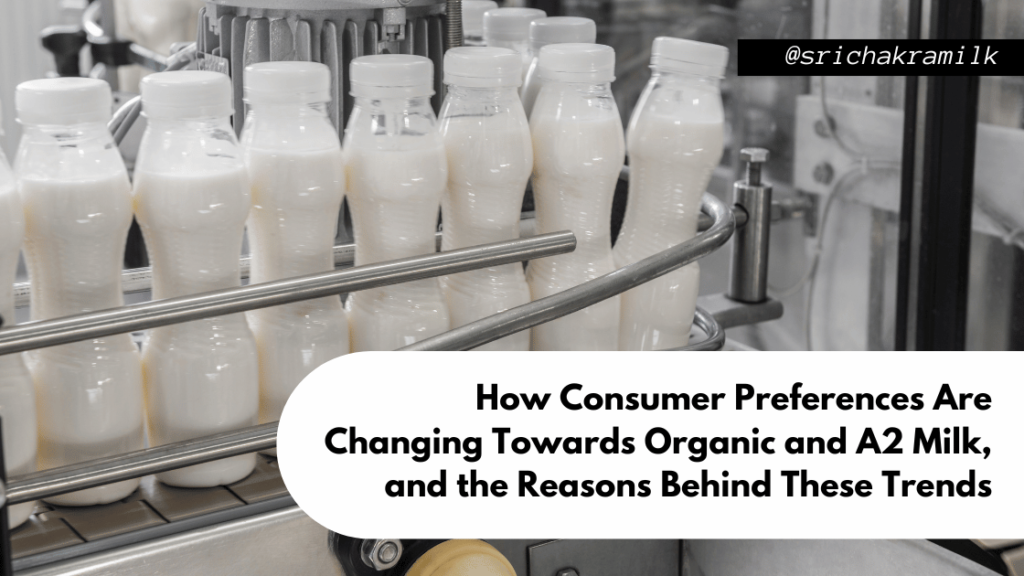Introduction
In recent years, consumer preferences in the dairy industry have undergone significant transformations, with a growing inclination towards organic and A2 milk. This shift is driven by a confluence of factors including health consciousness, environmental concerns, and ethical considerations. As we delve into this evolving landscape, we aim to uncover the underlying reasons behind the increasing demand for organic and A2 milk and explore how these preferences are reshaping the dairy market.
The Rise of Organic Milk
Understanding Organic Milk
Organic milk is produced from cows that are raised according to organic farming standards. These standards typically prohibit the use of synthetic pesticides, fertilizers, antibiotics, and genetically modified organisms (GMOs). Organic dairy farming emphasizes sustainable practices, such as rotational grazing, which not only ensure the health of the cows but also enhance the quality of the milk produced.
Benefits of Organic Milk
Organic milk is touted for several benefits, both in terms of health and environmental impact. From a health perspective, organic milk is often richer in omega-3 fatty acids, antioxidants, and vitamins compared to conventional milk. These nutritional advantages stem from the cows’ diet of organic feed and grass.
Environmentally, organic farming practices promote biodiversity and soil health, reduce pollution, and use resources more efficiently. Consumers who choose organic milk often do so because they value these environmental benefits alongside the health advantages.
Market Trends in Organic Milk Consumption
The market for organic milk has seen a steady rise as more consumers become aware of its benefits. Reports indicate a significant increase in sales, with organic milk occupying a growing share of the overall dairy market. This trend is fueled by a combination of increased consumer education and a broader availability of organic milk products.
The Emergence of A2 Milk
What is A2 Milk?
A2 milk comes from cows that produce milk containing only the A2 beta-casein protein, as opposed to the more common A1 protein found in most dairy products. The distinction between A1 and A2 proteins lies in their amino acid composition, which can affect how the body digests and responds to milk.
Health Benefits of A2 Milk
Proponents of A2 milk claim that it offers various health benefits, particularly for individuals who experience discomfort or digestive issues when consuming regular milk. Studies suggest that A2 milk may be easier to digest and less likely to cause gastrointestinal symptoms such as bloating and stomach pain. These potential benefits have made A2 milk a popular choice among health-conscious consumers.
Consumer Demand for A2 Milk
The demand for A2 milk has surged as more people seek alternatives to conventional milk that align with their health and wellness goals. Brands specializing in A2 milk have effectively marketed its digestive benefits, leading to increased consumer awareness and adoption. Additionally, the premium positioning of A2 milk has appealed to a segment of consumers willing to pay more for perceived health advantages.
Comparative Analysis: Organic vs. A2 Milk
Nutritional Differences
While both organic and A2 milk offer unique benefits, they differ in their nutritional profiles. Organic milk is often praised for its higher content of beneficial nutrients like omega-3 fatty acids and antioxidants. In contrast, A2 milk’s primary distinction lies in its protein composition, which may influence its digestibility and suitability for certain individuals.
Health Implications
Organic milk and A2 milk cater to different health concerns. Organic milk appeals to those looking to avoid synthetic chemicals and enhance their nutrient intake. A2 milk, on the other hand, targets consumers who experience digestive issues with conventional milk but do not wish to eliminate dairy from their diet entirely. Understanding these differences can help consumers make informed choices based on their specific health needs.
Factors Driving the Shift in Consumer Preferences
Health Consciousness
A growing body of research linking diet to health outcomes has made consumers more aware of the importance of making healthier food choices. This heightened health consciousness is a major driver behind the shift towards organic and A2 milk. Consumers are increasingly seeking out products that offer superior nutritional value and potential health benefits.
Environmental Awareness
Environmental sustainability is another critical factor influencing consumer preferences. Organic farming practices, which prioritize ecological balance and conservation, resonate with environmentally conscious consumers. Similarly, A2 milk, often marketed as a more natural and traditional form of dairy, appeals to those concerned about the environmental impact of industrial farming practices.
Animal Welfare
Ethical considerations regarding animal welfare also play a significant role in shaping consumer choices. Organic dairy farms typically adhere to higher animal welfare standards, including providing cows with access to pasture and avoiding the use of growth hormones. This humane treatment of animals is a key selling point for many consumers.
Taste and Quality
Taste and perceived quality are important factors in the decision-making process for many consumers. Organic milk is often described as having a richer, creamier taste compared to conventional milk. A2 milk’s appeal lies in its promise of a more natural and less processed product, which many consumers believe translates to better taste and quality.
Marketing Strategies for Organic and A2 Milk
Effective Branding
Strong branding is essential for differentiating organic and A2 milk products in a crowded market. Brands need to communicate their unique value propositions clearly, whether it’s the health benefits of A2 milk or the environmental advantages of organic milk. Effective branding can build consumer trust and loyalty, driving repeat purchases.
Consumer Education
Educating consumers about the benefits of organic and A2 milk is crucial for driving demand. Brands can leverage various channels, such as social media, blogs, and webinars, to provide information on the health, environmental, and ethical advantages of their products. Consumer education initiatives can help bridge the knowledge gap and encourage informed purchasing decisions.
Digital Marketing Approaches
Digital marketing strategies, including search engine optimization (SEO), content marketing, and influencer partnerships, can significantly enhance the visibility of organic and A2 milk brands. By creating high-quality, keyword-rich content that addresses consumer search queries, brands can improve their online presence and attract a larger audience.
Challenges in the Organic and A2 Milk Market
Pricing and Accessibility
One of the main challenges facing the organic and A2 milk market is the higher price point compared to conventional milk. The cost of organic farming practices and the selective breeding of A2 cows contribute to these higher prices. Making these products more accessible to a broader consumer base is crucial for sustained growth.
Regulatory Hurdles
Navigating the regulatory landscape can be challenging for producers of organic and A2 milk. Compliance with organic certification standards and labeling requirements involves significant time and resources. Similarly, A2 milk producers must ensure their products meet specific standards to differentiate them from conventional milk.
Supply Chain Issues
Maintaining a consistent and reliable supply chain is essential for meeting consumer demand. Organic dairy farming, in particular, can be susceptible to fluctuations in weather and other environmental factors. Ensuring a steady supply of high-quality organic and A2 milk requires robust logistics and supply chain management.
Future Outlook for Organic and A2 Milk
The future of organic and A2 milk looks promising as consumer preferences continue to evolve towards healthier and more sustainable options. Innovations in farming practices, advancements in dairy processing, and increased consumer education are expected to drive further growth in these markets. As awareness of the benefits of organic and A2 milk spreads, we can anticipate a broader adoption of these products, resulting in a more diversified and dynamic dairy industry.




